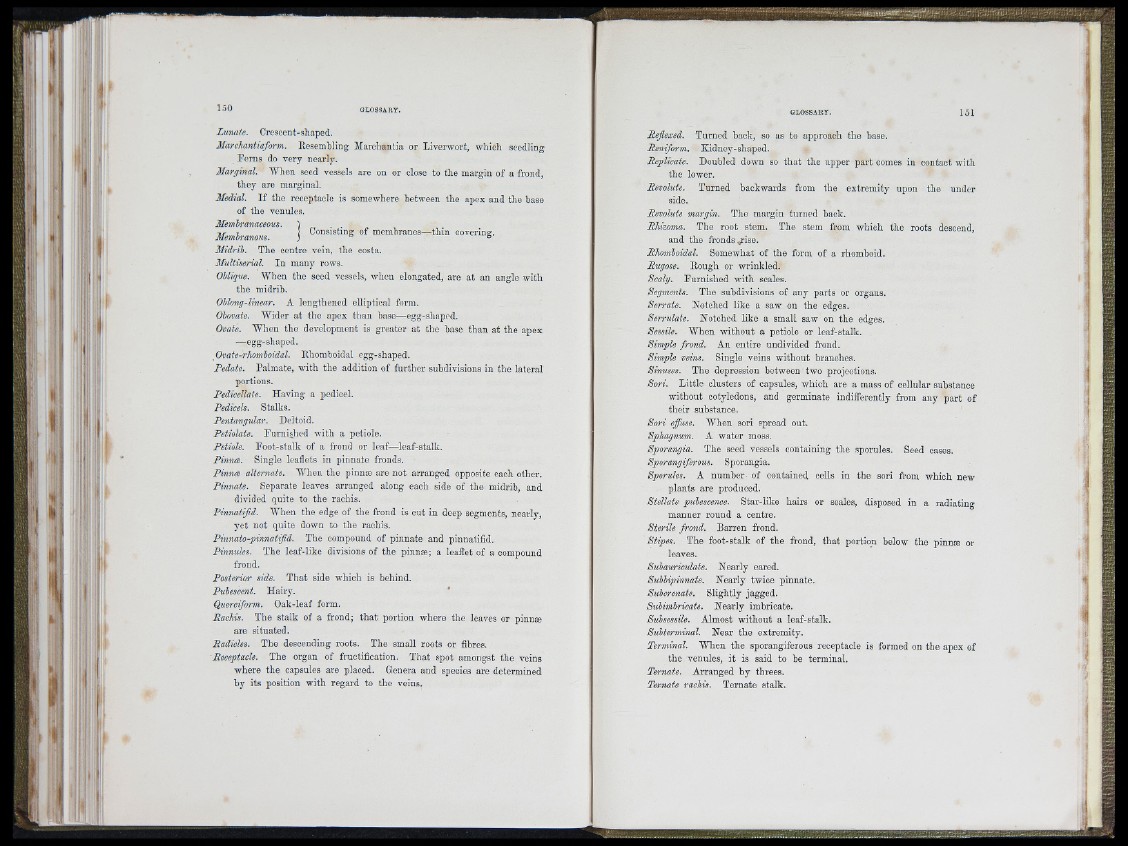
Ir I
I
ii iji.
if 4
Ii!
ii i
I) y
I ':'
Lunate, Crescent-shaped.
Marcliantiaform. lleseinbling Marchaniia or Liverwort, which seedling
Perns do very nearly.
Marginal. "When seed vessels are on or close to the margin of a frond,
they are marginal.
Medial. I f the receptacle is somewhere between the apex and the base
of the venules.
Mernhranaceous. )
Memlranous. Consisting of membranes—thin covering.
Midrib. The centre vein, the costa.
Multiserial. In many rows.
Oblique. When the seed vessels, when elongated, are at an angle with
the midrib.
Oblong-linear. A lengthened elliptical form.
Obovate. Wider at the apex tiian base—egg-shaped.
Ovate. AVhen the development is greater at the base than at the apex
—egg-shaped.
Ovate-rhomboidal. Rhomboidal egg-shaped.
Pedale. Palmate, with the addition of further subdivisions in the lateral
portions.
Having a pedicel.
Stalks.
Pentangular. Deltoid.
Petiolate. Furnished with a petiole.
Petiole. Foot-stalk of a frond or leaf—leaf-stalk.
Pinnæ. Single leaflets in pinnate fronds.
Pinnæ alternate. AATien the pinnæ are not arranged opposite each other.
Pinnate. Separate leaves arranged along each side of the midrib, and
divided quite to the rachis.
Pinnatifid. AA’hen the edge of the frond is cut in deep segments, nearly,
yet not quite down to the rachis.
Pinnato-pinnatifid. The compound of pinnate and pinnatifid.
Pinnules. The leaf-like divisions of the pinnæ; a leaflet of a compound
frond.
Posterior side. That side which is behind.
Pubescent. Hairy. '
Querciform. Oak-leaf form.
Rachis. The stalk of a frond; that portion where the leaves or pinnæ
are situated.
Radicles. The descending roots. The small roots or fibres.
The organ of fructification. That spot amongst the veins
where the capsules are placed. Genera and species are determined
by its position with regard to the veins.
Turned back, so as to approach the base.
orm. Kidney-shaped.
Doubled down so that the upper part comes in contact wdtli
the lower.
Revolute. Turned backwards from the extremity upon the under
side.
Revolute margin. The margin turned back.
Rhiwma. The root stem. The stem from which the roots descend,
and the fronds jise .
Rhomboidal. Somewhat of the form of a rhomboid.
Rugose. Rough or wrinkled.
Scaly. Furnished with scales.
Segments. The subdivisions of any parts or organs.
Serrate. Notched like a saw on the edges.
Serrulate. Notched like a small saw on the edges.
Sessile. When without a petiole or leaf-stalk.
Simple frond. An entire undivided frond.
veins. Single veins without branches.
The depression between two projections.
Sori. Little clusters of capsules, which are a mass of cellular substance
without cotyledons, and germinate indifferently from any part of
their substance.
Sori effuse. When sori spread out.
Sphagnum, A water moss.
The seed vessels containing the sporules. Seed cases.
Sporangia.
A number of contained cells in the sori from which new
plants are produced.
Stellate pubescence. Star-like hairs or scales, disposed iu a radiating
manner round a centre.
Sterile frond. Barren frond.
Stipes. The foot-stalk of the frond, that portion below the pinnæ or
leaves.
Subauriculate. Nearly eared.
Suhbipinnate. Nearly twice pinnate.
Suborenate. Slightly jagged.
Subimbricate. Nearly imbricate.
Almost without a leaf-stalk.
Near the extremity.
Terminal. AVhen the sporangiferous receptacle is formed on the apex of
the venules, it is said to be terminal.
Ternate. Arranged by threes.
Ternate Ternate stalk.